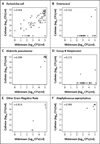Voided midstream urine culture and acute cystitis in premenopausal women
- PMID: 24224622
- PMCID: PMC4041367
- DOI: 10.1056/NEJMoa1302186
Voided midstream urine culture and acute cystitis in premenopausal women
Abstract
Background: The cause of acute uncomplicated cystitis is determined on the basis of cultures of voided midstream urine, but few data guide the interpretation of such results, especially when gram-positive bacteria grow.
Methods: Women from 18 to 49 years of age with symptoms of cystitis provided specimens of midstream urine, after which we collected urine by means of a urethral catheter for culture (catheter urine). We compared microbial species and colony counts in the paired specimens. The primary outcome was a comparison of positive predictive values and negative predictive values of organisms grown in midstream urine, with the presence or absence of the organism in catheter urine used as the reference.
Results: The analysis of 236 episodes of cystitis in 226 women yielded 202 paired specimens of midstream urine and catheter urine that could be evaluated. Cultures were positive for uropathogens in 142 catheter specimens (70%), 4 of which had more than one uropathogen, and in 157 midstream specimens (78%). The presence of Escherichia coli in midstream urine was highly predictive of bladder bacteriuria even at very low counts, with a positive predictive value of 10(2) colony-forming units (CFU) per milliliter of 93% (Spearman's r=0.944). In contrast, in midstream urine, enterococci (in 10% of cultures) and group B streptococci (in 12% of cultures) were not predictive of bladder bacteriuria at any colony count (Spearman's r=0.322 for enterococci and 0.272 for group B streptococci). Among 41 episodes in which enterococcus, group B streptococci, or both were found in midstream urine, E. coli grew from catheter urine cultures in 61%.
Conclusions: Cultures of voided midstream urine in healthy premenopausal women with acute uncomplicated cystitis accurately showed evidence of bladder E. coli but not of enterococci or group B streptococci, which are often isolated with E. coli but appear to rarely cause cystitis by themselves. (Funded by the National Institute of Diabetes and Digestive and Kidney Diseases.).
Conflict of interest statement
Dr. Hooton reports receiving consulting fees from Merck and Pinnacle Pharmaceuticals and having an equity interest in Fimbrion Therapeutics. No other potential conflict of interest relevant to this article was reported.
Figures


Comment in
-
Uncomplicated cystitis--not so simple.N Engl J Med. 2013 Nov 14;369(20):1959-60. doi: 10.1056/NEJMe1312412. N Engl J Med. 2013. PMID: 24224629 No abstract available.
-
Infection: Utility of midstream urine cultures questioned.Nat Rev Urol. 2014 Jan;11(1):3. doi: 10.1038/nrurol.2013.287. Epub 2013 Dec 3. Nat Rev Urol. 2014. PMID: 24296707 No abstract available.
-
Voided midstream urine culture is a good test for acute cystitis in premenopausal women.Evid Based Med. 2014 Aug;19(4):151. doi: 10.1136/eb-2013-101693. Epub 2014 Mar 3. Evid Based Med. 2014. PMID: 24591543 No abstract available.
-
Re: voided midstream urine culture and acute cystitis in premenopausal women.J Urol. 2014 May;191(5):1300. doi: 10.1016/j.juro.2014.01.024. Epub 2014 Jan 15. J Urol. 2014. PMID: 24745498 No abstract available.
-
Zystitis--Unkomplizierte Zystitis--doch nicht so einfach?Aktuelle Urol. 2014 Jul;45(4):261-2. doi: 10.1055/s-0034-1389227. Epub 2014 Aug 28. Aktuelle Urol. 2014. PMID: 25166602 German. No abstract available.
Similar articles
-
Re: voided midstream urine culture and acute cystitis in premenopausal women.J Urol. 2014 May;191(5):1300. doi: 10.1016/j.juro.2014.01.024. Epub 2014 Jan 15. J Urol. 2014. PMID: 24745498 No abstract available.
-
Voided midstream urine culture is a good test for acute cystitis in premenopausal women.Evid Based Med. 2014 Aug;19(4):151. doi: 10.1136/eb-2013-101693. Epub 2014 Mar 3. Evid Based Med. 2014. PMID: 24591543 No abstract available.
-
Infection: Utility of midstream urine cultures questioned.Nat Rev Urol. 2014 Jan;11(1):3. doi: 10.1038/nrurol.2013.287. Epub 2013 Dec 3. Nat Rev Urol. 2014. PMID: 24296707 No abstract available.
-
Effectiveness of Preanalytic Practices on Contamination and Diagnostic Accuracy of Urine Cultures: a Laboratory Medicine Best Practices Systematic Review and Meta-analysis.Clin Microbiol Rev. 2016 Jan;29(1):105-47. doi: 10.1128/CMR.00030-15. Clin Microbiol Rev. 2016. PMID: 26598386 Free PMC article.
-
[Asymptomatic bacteriuria].Med Klin (Munich). 2000 Apr 15;95(4):195-200. doi: 10.1007/pl00002106. Med Klin (Munich). 2000. PMID: 10808300 Review. German.
Cited by
-
Urine cultures at the onset of febrile neutropenia rarely impact antibiotic management in asymptomatic adult cancer patients.Support Care Cancer. 2019 Apr;27(4):1223-1227. doi: 10.1007/s00520-018-4476-7. Epub 2018 Sep 27. Support Care Cancer. 2019. PMID: 30259115
-
Bacterial species and antimicrobial resistance differ between catheter and non-catheter-associated urinary tract infections: Data from a national surveillance network.Antimicrob Steward Healthc Epidemiol. 2023 Mar 20;3(1):e55. doi: 10.1017/ash.2022.340. eCollection 2023. Antimicrob Steward Healthc Epidemiol. 2023. PMID: 36970431 Free PMC article.
-
Sampling of urine for diagnosing urinary tract infection in general practice - First-void or mid-stream urine?Scand J Prim Health Care. 2019 Mar;37(1):113-119. doi: 10.1080/02813432.2019.1568708. Epub 2019 Jan 28. Scand J Prim Health Care. 2019. PMID: 30689471 Free PMC article.
-
Longitudinal variability in the urinary microbiota of healthy premenopausal women and the relation to neighboring microbial communities: A pilot study.PLoS One. 2022 Jan 14;17(1):e0262095. doi: 10.1371/journal.pone.0262095. eCollection 2022. PLoS One. 2022. PMID: 35030190 Free PMC article.
-
Reevaluation of the Acute Cystitis Symptom Score, a Self-Reporting Questionnaire. Part II. Patient-Reported Outcome Assessment.Antibiotics (Basel). 2018 May 21;7(2):43. doi: 10.3390/antibiotics7020043. Antibiotics (Basel). 2018. PMID: 29883423 Free PMC article.
References
-
- Schappert SM, Rechtsteiner EA. Ambulatory medical care utilization estimates for 2007. Vital Health Stat. 2011;169:1–38. - PubMed
-
- Foxman B, Brown P. Epidemiology of urinary tract infections: transmission and risk factors, incidence, and costs. Infect Dis Clin North Am. 2003;17:227–41. - PubMed
-
- Marple CD. The frequency and character of urinary tract infections in an unselected group of women. Ann Intern Med. 1941;14:2220–39.
-
- Kass EH. Asymptomatic infections of the urinary tract. Trans Assoc Am Physicians. 1956;69:56–64. - PubMed
Publication types
MeSH terms
Grants and funding
LinkOut - more resources
Full Text Sources
Other Literature Sources
Medical
